Wine Tidbits
Gavi is one of the best Italian white wine produced in Piedmont.
Gavi is named after the comune located at the center of its production area.
Cortese is the local grape known for over 400 years and it is exclusively
used to make Gavi. Gavi is a dry white wine with a fresh and sharp acidity. Frizzante
and spumante are also produced with Cortese. Gavi gained DOCG status in 1998.
■ View more Gavi
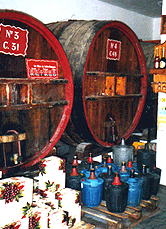
Ripasso method is a technique where Valpolicella wine is "re-passed" on the dried grape skins of
Amarone, while still warm and rich in sugar. The Valpolicella remains in contact with the pomace of Amarone for
about two weeks, during which period a second alcoholic fermentation occurs.
Ripasso method gives Valpolicella wine a better structure and a lower acidity, hence the
wine beomes more rounded and suitable for aging in barrels for as long as 18 months.
■ View Ripasso
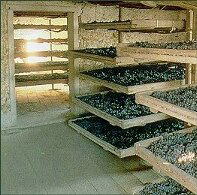
Amarone is a full bodied red wine produced with semi-dried grapes in a region called Valporicella
in Verona,Italy. The grapes, mainly Corvina, Rondinella, and Molinara, are allowed to dry on bamboo racks or
straw mats for a few weeks up to several months in a process called "Appassimento" to get sugars concentrate
and to produce raisiny flavors.
Following the drying process that is completed in three to four months, the grapes are crushed
and go through a dry and low temperature fermentation process that may continue up to 30 or 50 days.
The reduced water content can slow down the fermentation process, increasing the risk of spoilage
and potential wine faults such as high volatile acidity. After fermentation, Amarone undergoes a period
of a natural aging in wood which may be in oak barriques, resulting in full bodied, ripe, with delightful
bitterness("amaro" in Italy), rich in flavor, and alcoholic characteristics.
■ View Amarone
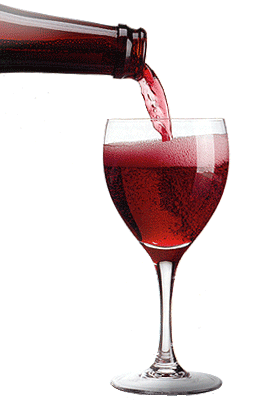
Lambrusco is a group of grape varieties that is cultivated in the province of Emilia Romagna
in northern Italy, and also refers to sparkling wine with dark ruby color made from the grapes.
It is light(alcohol content 11%), sparkling, and has complex aromas of cherries and wild strawberries.
Lambrusco pairs well with grilled meat or light lunches.
■ View Lambrusco
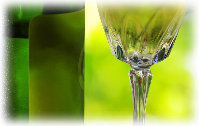
Vinho Verde generally refers to a white wine with a pale yellow color in Minho region with fertile and rich
granite soils along rivers that flow from the mountains of the east to the Atlantic Ocean in the
northern part of Portugal. Vinho Verde is the largest DOC of Portugal.
Alvarinho or Loureiro are harvested
about a week before the grapes get ripe, resulting in a fresh acidic wine with low alcohol content.
Flavour depends on the grape varieties used - floral for Loureiro and the fine, mineral,
subtly fragrant for Alvarinho.
Other types of Vinho Verde are Spumante, and red sparkling wine called Vinhao made from the same name.
Vinho Verde is the largest DOC of Portugal, up in the cool, rainy, verdant north west.
The vines grow in fertile, granite soils along rivers that flow from the mountains of the east
to flow into the ocean between surfing beaches. The wine is still distinguished by its high
acidity. Flavour depends on the grape varieties used - floral Loureiro, steely Trajadura, mineral
Arinto (known here as Pedernã), creamy and mineral Avesso, and the fine, mineral, subtly fragrant Alvarinho.
■ View Vinho Verde
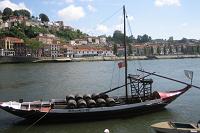
Port is a sweet fortified wine made in the region of Douro Valley in northern Portugal.
They are made by mixing Portuguese indigenous grapes, including Touriga Nacional, Touriga Franca,
Tinta Roriz, Tinta Barroca. When the alcohol level reaches around 7% in fermentation, brandy is
added stop fermentation. The residual sugar level is kept considerably higher than most still wines.
The wine packed in a barrel in the Alto Douro area is carried over to the town of Villa Nova de Gaia
in the estuary of the Douro River, where it is stored and aged in large casks for 18 months or longer.
The finished wine may be transferred to bottles or stay in casks depending on the style. The name "Port"
is derived from the city of Porto located at the mouth of the Douro River, where ships loaded with Port
set sail to England.
■ View Port wine

Wine making in clay, or amphorae is nothing new. In fact, the practice originated in what
is now modern-day Georgia, some 6,000 years ago and amphorae has been the major wine
vessels in the region until recently. The last decade has witnessed an increasing
number of vintners across Europe, many of whom are working on an organic or
biodynamic basis, making the efforts to come to back the roots of wine making methods.
The tannins in the grape skins, pips and stalks provide a natural preservative,
reducing the needs for sulphur in amphorae. White grapes with their skins make orange
wines, imparting colour, flavour and tannin. Like oak, clay is porous, therefore it allows
some oxygen to pass through the wall, giving the wine a deep and rich texture, but like steel clay won't
impart any additional flavours.
Yeast and sediment precipitates naturally at the bottom of the conical pot, reducing the need
to filter or fine the wine.
■ View Amphora wine
Pét-Nat is short for pétillant naturel, a French term meaning "naturally bubbling".
Pét-nat is made with what is known as the "ancestral" method, which is the oldest version of
sparkling wine making originating in France. The little intervention process associated with
Pét-Nat has created popularity among organic and biodynamic wine producers and the natural wine lovers.
The process involves bottling before first fermentation has finished, allowing the process to
complete in bottle resluting in light fizz, with less alcohol, and usually unfiltered and cloudy wine.
■ Pét-Nat wines
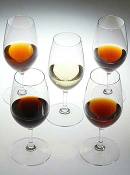
Sherry(Xeres in Spanish)is a fortified wine, produced in the province of Andalucia.
Contrary to widely held perceptions,the majority of sherry is dry.
Under Spanish law, "Sherry" must legally come from the Sherry Triangle, an area in the
province of Cádiz between Jerez de la Frontera, Sanlúcar de Barrameda, and El Puerto de Santa María.
Wines which are produced in the area of Montilla-Moriles or Málaga to the west of Sherry
Triangle with the same method are called Sherry Type.
The soil in this region is called albariza, rich in chalk, limestone, and sand. This
provides the perfect conditions for growing three grapes Palomino, Pedro Ximénez and Moscatel,
used for making sherry wine.
A layer of yeast produced on the surface of the wine is called "Flor", and this
provides specific taste to sherry.
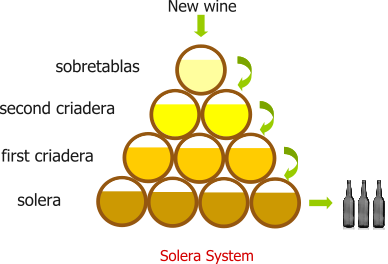
Sherry is produced in a unique and complex maturation system with repeated
fractional blending called Solera first developed in Sanlucar de Barrameda.
Barrels in solera are arranged in multiple tiers. Each tier contains the wine
of the same age. The oldest tier at the bottom(confusingly called solera as well)
contains the sherry which is ready to be bottled. When a fraction of the sherry
is extracted from the solera it will be replaced with the same amount of the sherry
in the tier immediately above called first criadera, which is slightly younger.
This, in turn, will be filled up with wine from the second criadera and so on. The
last criadera called sobretablas containing the youngest wine is filled up with new
wine.
This process of blending and aging may sometimes practiced several times a year and
sherry must be aged 3 years before being sold by law, but most are aged longer resulting
in complex taste and consistency. Although solera system is often represented
by the figure here, barrels may be stacked in blocks rather than rows in manufacturers
with larger scale.
Although it is a common practice to fortify sherry type with spirits during fermentation,
the wines produced in Montilla-Moriles with Pedro Ximénez reaches high
alcohol levels due to the high sugar content of the grape.
『Types of Sherry』
Fino: This is made from the Palomino grape under a layer of a layer
of yeast called flor. Flor prevents contact with air, suppressing oxidation
,resulting in fresh and dry wine pale yeallow in color with notes of almond.
Maturation in wooden barrels for two years is mandatory, but some Finos are
agred more than four yeas. To be served chilled between 4 and 9℃.
Alcohol content: 15-18%
Amontillado: Amontillado starts as Fino and goes through slow oxidation
under flor for the first three to eight years, then matured further without
flor. Along the way, Amontillado becomes fully dry and gains a darker and richer
flavor than Fino, with nutty aromas, tobacco, and spicy notes. To be served around
12℃. Alcohol content: 16-22%
Oloroso: Oloroso is oxidized and aged in the absence of flor. To create Oloroso the
base wine is fortified to 17 to 18% alcoholc content, which makes flor yeast unable to
survive in the casks. Resulting wine is dry, full bodied, round with amber color
and nutty aromas with balsamic notes and toasted hints. This gives this wine the name
"Olor" which means odor in Spanish. To be served around 15-16℃. Alcohol content: 17-22%
Cream: Cream is usually produced by blending Oloroso with naturally sweet Pedro
Ximénez. The name "Cream" is originated from widely consumed Bristol Cream from
Bodegas Harvey, which has been producing sweet sherry since 17th centry.
Smooth and velvety in the mouth, dark in color and notes of oak and raisin. Cream
goes well with a variety of pastry or mature cheese. Best to be
served chilled, between 10 and 12℃. Alcohol content: 15-22%
Pedro Ximénez: This is made from the grape Pedro Ximénez very ripe and/or dried
in the sun to concentrate resulting in intensely sweet wines. This resulting wine is
soft and velvety rich in sweet aroma s of figs, chocolate, coffee and spices。
To be served chilled around 10℃. Alcohol content: 15-22%
■ View Sherry Type wines
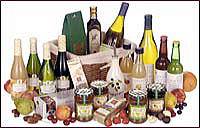
Sulfites are a preservative to wine. Although there seem no historical proof that the
ancient Greeks and Romans used sulfur as a wine preservative as it is widely discussed,
sulfur has been used over 600 years by wine producers to prevent the wine from turning
to vinegar and to stop bacteria and other yeasts from growing.
The level of added sulfite allowed for wine is low in general, and the Japanese Food Sanitation Act
set the level to 350ppm. However, in response to claim that sulfite causes headache, asthema
or itching to some people, some wine producers make great effort to reduce the level of
sulfite in wine even lower while maintaining the quality of their wines.
The EC regulation
934/2019 has taken effect since 2012, and regulates the maximum level of sulfite in
organic wine to 100ppm for red wine, 150ppm for white wine
and roses and 155ppm for sparkling wine.
Some organic wine producers have taken a step further and NOT TO ADD sulphite at all. They
are conventionally called sulfite(or SO2) free wine. We take utmost care to keep these wines
intact.
In Biodynamic farming, no chemical fertilizers or pesticides are ever used. Instead, the earth
is renewed by sowing vegetarian mulch which enriches the nutritional content. Rather than pesticides,
key herbs are planted which are attractive to “good” insects, which take care of the “bad” insects
naturally. But this is only the beginning. Following detailed work calendars organized at the beginning
of each year from the Biodynamic advising boards around the world, certain tasks are assigned to certain days.
As the moon waxes (moves toward the full-moon phase) the sap rises. This is then the prescribed period for
harvesting crops. As the moon wanes (moving from full moon to half) the sap falls, which is then the time for
fertilization, trimming, etc. Rudolf Steiner is the originator of this approach. He taught that growth was
influenced by a flow of energy radiating from the moon, stars and planets.
Biodynamic wines are certified by a few bodies including DEMETER. However some Biodynamic wine producers couldn't be careless about obtaining the certification. We call these wines Biodynamically produced wines.
Since sulfite is a natural byproduct of fermentation, there is no such things as sulfite free wine.
Sulfites are a known preservative to wine for hundreds of years to stop bacteria and other yeasts
from growing and reduces oxidation of the wine.
In order to eliminate some concerns about sulfite related allergy or sickness, some wine producers
have been challenging NOT TO ADD sulfite. Some of the basic practice are to clean the tanks and
devices thoroughly, to fill inert gases to provide a buffer between these organisms and oxygen,
and to minimize exposure to ambient before bottling.
When you have purchased no added sulfite wine, you are advised to keep it in darkness at
controlled temperatures and NOT to leave it for excessively long period.
■ View No Added Sulfite wine
Natural wines, also called raw wine or living wine, are wines which are produced with minimal intervention in
growing vines as well as in processing grapes into wine. Natural Wine is farmed organically or biodynamically
and no or very small amount of sulfite may be added, and also neither fining nor (tight) filtration
is used. The result is a living wine with distinctive taste, wholesome and rich in naturally occurring
microbiology.
However there is no legislation bodies or consensus around its exact definition as of writing.
This name is therefore not certified yet. Each wine producer has different ways to create their
natural wine and there are several "Grower associations".
■ View Natural wine
"Orange Wine" is NOT made with oranges, but it is named after the color of the wine,
where white grapes are processed together with the skins and seeds(skin contact)
for weeks or months.This method is nothing new and archaeological findings indicate this
wine making method could have been carried out several thousand years ago in the Middle East
in the area including Georgia and Egypt. However it is only the last 20 years or so that
the orange wine process is in the limelight, this time in northeastern Italy and
neighbouring Slovenia. It is a common practice to use wild yeast and minimum amount of sulfite.
The tannins, lignin in particular, extracted from the skin and seeds add orange color and
characteristic aroma of tropical fruits, hazelnuts, juniper and spicy taste to the wine, which make
"Orange Wine" special.
Orange wines taste best around 10 degrees, which is slightly warmer than for typical white wine. Orange wines
are bold and complex and they can pair well with curry and spicy food as well as wide vaiety of
meats including beef and fish.
■ View Orange Wine
The number of Vegans has increased the last few years; and although this lifestyle is
becoming more and more common, those who are committed to it are faced with many challenges,
of which wine is not exempt.
Organic wine is not necessarily vegan. Indeed, many of the substances that may be
used as fining agents are derived from animals, for example, casein (milk protein), chitin (fiber from
crustacean shells), egg albumins (derived from egg whites), fish oil, gelatin (protein from
boiling animal parts), and isinglass (gelatin from fish bladder membranes).
There are alternatives. Some wine producers are turning to agents such as kaolin(clay)
, bentonite(clay), and limestone in order to filter their wine. These wine are called vegan wine
and indicated by the the logo of a vegan certification body, such as the Vegan Society, on the label.
Some producers do not dare to obtain the certification, and we call their wines "Vegan uncertified".
■ View Vegan wine
PIWI is a German term, pilzwiderstandsfähige Rebsorten, which stands for fungus-resistant vines.
As a result of extensive research in Germany since early 1990s, several strains that show resistant to diseases such as Powdery mildew and Downy mildew have been developed across Europe with cross breeding (NOT with genetic modification) of European varieties and American fungus resistant varieties. Many strains have been developed worldwide ever since.
To name a few varieties, Regent(red), Merlot Khorus(red), and Bronner(white). Ref: https://piwi-international.de/en/
This new technique is expected to achieve significant reduction in the usage of pesticide and fungicide, thus contributing sustainability to the environment.
■ View PIWI wines

The Ideal temperature for wine storage is a constant ambient temperature around 10-16°C,
but higher temperature may be tolerated as long as the fluctuation is kept to a minimum.
If a cellar is not available, find a dark cupboard or closet with ventilation and a constant
temperature. Wine is spoiled by long-term exposure to direct sunlight or daylight.
Constant agitation or vibration can cause wine to age prematurely. Keep wine away from the
vibrations. Wine should be stored on its side to keep the cork moist and tight against the
bottle neck to prevent the cork from drying out in a long run and shrinking, and allowing
oxygen to get into the bottle and damage the wine. Wine bottles with screw tops or plastic
cork need not be stored on their sides.

Franciacorta is a sparkling wine from Brescia in Lombardy,northern Italy with DOCG status produced
from grapes grown within the boundaries of the territory of Franciacorta.
Grape varieties that can be used to make this Italian sparkling wine are the classic ‘Champagne varieties’
of Chardonnay and Pinot Noir, plus also Pinot Blanc.
Franciacorta is also produced using the ‘traditional method’ – same as in Champagne – with a second
fermentation taking place in the bottle.
The emergence of cork alternatives has grown in response to quality control efforts
by winemakers to protect against "cork taint" caused by the presence of the chemical, trichloroanisole (TCA),
in the cork.
Synthetic corks are made from plastic compounds designed to look and "pop" like natural cork,
but without the risk of TCA contamination. The disadvantages of some synthetic corks is a risk of harmful
air entering a bottle sooner than natural cork. Also many of the synthetic corks are made from
material that is not biodegradable.
Screw caps are closures made from aluminium material plus a layer of plastic, cork, rubber, or other soft
material used as wad to make a seal with the mouth of the bottle. Despite the screwcap's public image,
something for cheap wines, screw caps reduce the wine faults of oxidation and of cork taint generally and
are perceived as easier to open and have a much lower failure rate than cork.
Polyphenols are a group of diverse chemicals having large multiple phenol structural units and are present
in many vegetables and plants. The numbers and characteristics of these phenol structures define wide
variety of their chemical and biological properties, including antioxidant and anti-inflammatory effects.
Polyphenols may be classified to two groups, flavonoids and non-flavonoids, depending on their structural
characteristic. Approximately 90% of polyphenols in red wine are flavonoids. Anthocyanins, Catechin,
Tannins are some of the well known molecules.
Hundreds of polyphenols that can be present in wine derive mostly from grape seeds and skin and this
is the reason why red wine is rich in polyphenol. Multiple polyphenols may be conjugated to form large
molecules, which helps to reduce astringency and increase round taste. Antocyanin, a source of red color,
turns dark red or brown as oxidized, whereas the red color holds when the molecule is conjugated with tannins.
Tannin is a group of diverse set of molecules that can affect the color, aging ability and texture of the wine.
They provide sense of stringency in the mouth owing partly to the tendency of tannin to react with proteins.
The reaction of tannins and anthocyanins with catechins creates another class of tannins known as pigmented
tannins that influence the color of red wine.
Resveratrol produced by grape vines provides defense against microbes. The French Paradox involving the health
of wine drinkers in France lead to extensive studies and the discovery of beneficial effects including anti-oxidant,
anti-inflammatory and anti-carcinogenic properties.
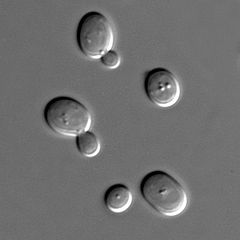
A ripe grape has sugars and wild yeasts living on its skin. As soon as the skin of the grape is broken,
fermentation gets started. Fermentation is the process where sugar is converted to alcohol by yeast and
the process will continue until all the sugar has been turned into alcohol or the level of alcohol
in the juice reaches around fifteen percent, whichever is sooner. At around fifteen percent alcohol,
the yeasts will die naturally and any left over sugars will remain in the wine.
Although the most common yeast generally participating in wine making process is Saccharomyces cerevisiae, other genera of
yeast can be involved either positively or negatively. Kloeckera, Candida, and Pichia work in
relatively low alcohol environment. They, in addition to Saccharomyces cerevisiae that is resident to
wineries, also form a group called "wild yeast" as opposed to inoculated or cultured yeast.
Beyond the alcohol level over four to six percent Saccahromyces cerevisiae is the only species that
survives and fermentation continues until it reaches around fifteen percent alcohol.
When all of the sugars have been consumed by yeast dry wine is produced. If the fementation is stopped
by chilling the must or addition of sulfite the resulting wine is low in alcohol and sweet.
While alcohol is the primary product in fermentation, there are a number of other products that
infulence the wine, including glycerol, fusel oils, sccinic acid, various esters.
Malolactic fermentation (or MLF) is a process in winemaking in which tart-tasting malic acid, naturally
present in grape must, is converted to softer-tasting lactic acid. Malolactic fermentation is most
often performed as a secondary fermentation shortly after the end of the primary fermentation,
but can sometimes run concurrently with it. The process is standard for most red wine production and
common for some white grape varieties such as Chardonnay, where it can impart a "buttery" flavor
from diacetyl, a byproduct of the reaction
Malolactic fermentation tends to create a rounder, fuller mouthfeel. Malic acid is typically associated
with the taste of green apples, while lactic acid is richer and more buttery tasting.
In addition to malolactic acid , the main product, lactic acid, diacetyl(or 2,3-butanedione), acetic acid,
acetoin, and various lactic acid esters provide aromatic flavor and add “body” to wine.
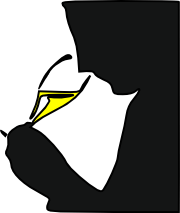
The source of wine flavors are volatile small molecules. Although some of them are originated
from grapes, hundreds of molecules are produced during fermentation and aging processes,
To name a few, a group of esters provides fruity flavors, including bananas, apples, and white
flowers. Beta-ionone provides violoet flavor noted in riesling, and beta-damascenone is
the source of rose like flavor often found in chardonnay. Terpens are rich source of flavors
,including linalool which is the source of muscat flavor often associated with Gewuerztraminer,
and geraniol imparts a rose-like flavor note.
Vanila like flavor produced in aging in oak barrels is vanillin. Oaklactone alone gives coconuts
flavor, however this is a major source of oak flavor in wine.
Some guaiacols and phenols can contribute bacon, clove or smoky aromas.

"REEFER”refers to the transportation of wines from wineries to customers in refrigerated shipping containers,
known as "reefer" containers, which keep the wine at a constant temperature around 15°C throughout
the entire journey on land and across oceans.
We choose REEFER to prevent our organic wines from heat damage and to maintain the genuine taste.
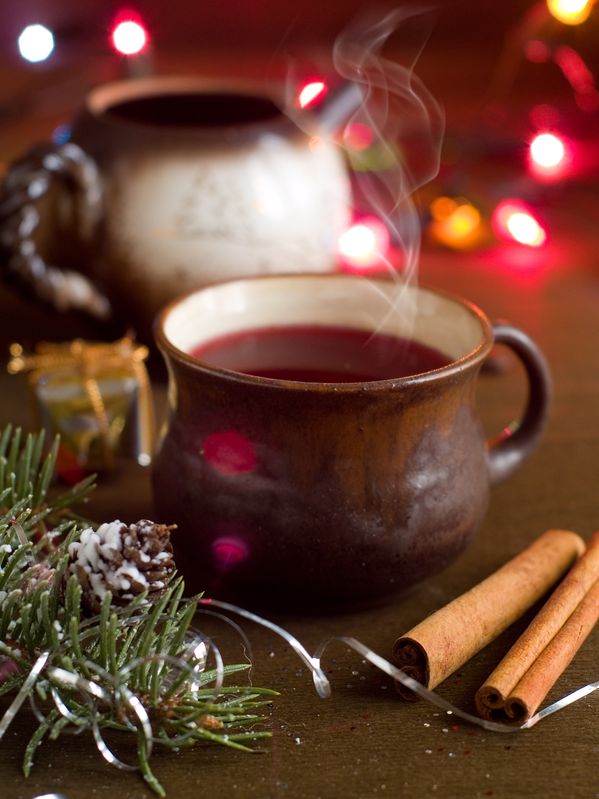
Mulled wine or "Glühwein" in German or "Vin Chaud" in French is a type of wine cocktail
that is served warm and with added spices.
To make mulled wine, combine red wine, sugar or syrup and spices such as orange peel, cinnamon, and clove(and
brandy, anise or whatever, depending on your taste....) and bring it to simmer. Reduce heat
to medium-low, and let the wine simmer for 15 minutes or longer. Strain and serve
warm with your desired garnishes.
It is a traditional drink to be enjoyed during winter.